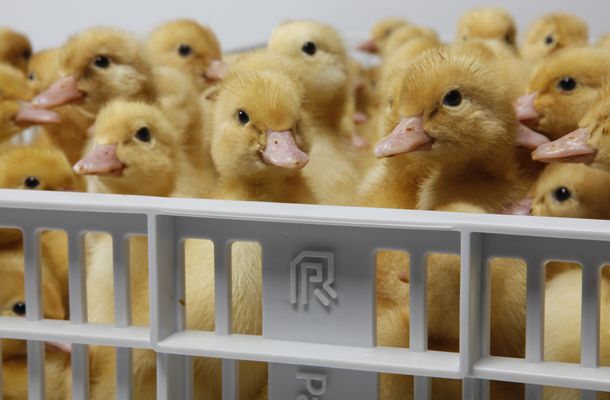Incubating duck and goose eggs
Tags: Incubation | Whitepaper
, 28 May 2020

There are relatively few hatcheries that specialise in waterfowl. Their programs and procedures are largely based on traditions and many years of practical local experience.
Usually, people try to mimic Mother Nature. Waterfowl nest close to water, and a brooding female returns to the nest from the water wet and chilled. It would seem that these conditions help hatchability, as it is rare to find an unhatched egg in the nests of wild ducks or geese.
As a result, spraying eggs during incubation became a standard procedure. This begins somewhere between day 10 and 14, and is continued until the eggs are transferred. Trolleys must be moved out of the setter; the eggs are sprayed with lukewarm or cold water and then returned to the setter. In a multistage setter, the effect on the other eggs in the machine is only temporary. A single-stage machine needs much more time for the settings to be restored.
Generally, two types of trays are in use: plastic trays, where the eggs stand upright, and metal-wire trays where the eggs lie flat or are half-tilted. Some goose hatcheries claim that combining spraying with turning the eggs manually an extra time each day along their long axis also has a positive impact. However, this requires a lot of manual work, which can be a problem as hatcheries are getting bigger and labour costs higher.
Not surprisingly, the waterfowl branch is looking for shortcuts. The fundamental questions are: what is the actual effect of the spraying? Does it simply cool the eggs down? Or does it have another function? And is it necessary?
Waterfowl eggs differ physically from hen eggs. To cope with the humid environment, they have a strong waxy coating – a cuticle. This coating protects them from infections. However, this “tight packing” impedes the exchange of gases and evaporation of water. Its structure must become open early enough to provide the growing embryo with sufficient oxygen and create an air cell big enough to facilitate hatching.
We can override nature by removing the cuticle in advance. This can be done by washing the eggs with a sodium hypochlorite solution in a specialised washer under strictly controlled conditions. However, washing makes the “naked” eggs much more vulnerable to infections. Hygiene in the hatchery therefore needs to be perfect and should include early removal of “clears” and early deads, absorption of contaminated air at transfer, and good control of fluff at hatch. These extra requirements are balanced by the elimination of spraying and make incubation of waterfowl eggs as simple as for chicken eggs.
Another possible option – used by some hatcheries – is a single-stage incubation, where setter inlets, outlets and door are fully sealed for the first 14-17 days. Eggs must be clean, fresh and good quality, but not disinfected. As long the ventilation remains closed, humidity stays at 80% or higher, and the CO2 concentration can rise as high as 1%. No spraying is practised later on. Although not very common, this system leads to surprisingly good hatch results.
Conclusions
- The main problem when incubating waterfowl eggs is controlling cuticle status. The cuticle can be gradually destroyed by spraying, creating specific microclimate conditions, or removed by using a chemical wash.
- The cooling effect of spraying is most likely not relevant. Chemically washed eggs hatch well without spraying.
- Microflora apparently play an important role in destroying the cuticle. Spraying seems to help microflora to “consume” the cuticle.
- Tray type, egg position, and manual turning along the long axis (to reach all sides of the egg) only matter if spraying is done.
Written by Maciej Kolańczyk
Senior Hatchery Specialist
I welcome your feedback on this article - and if you require any additional information, please don't hesitate to contact me.